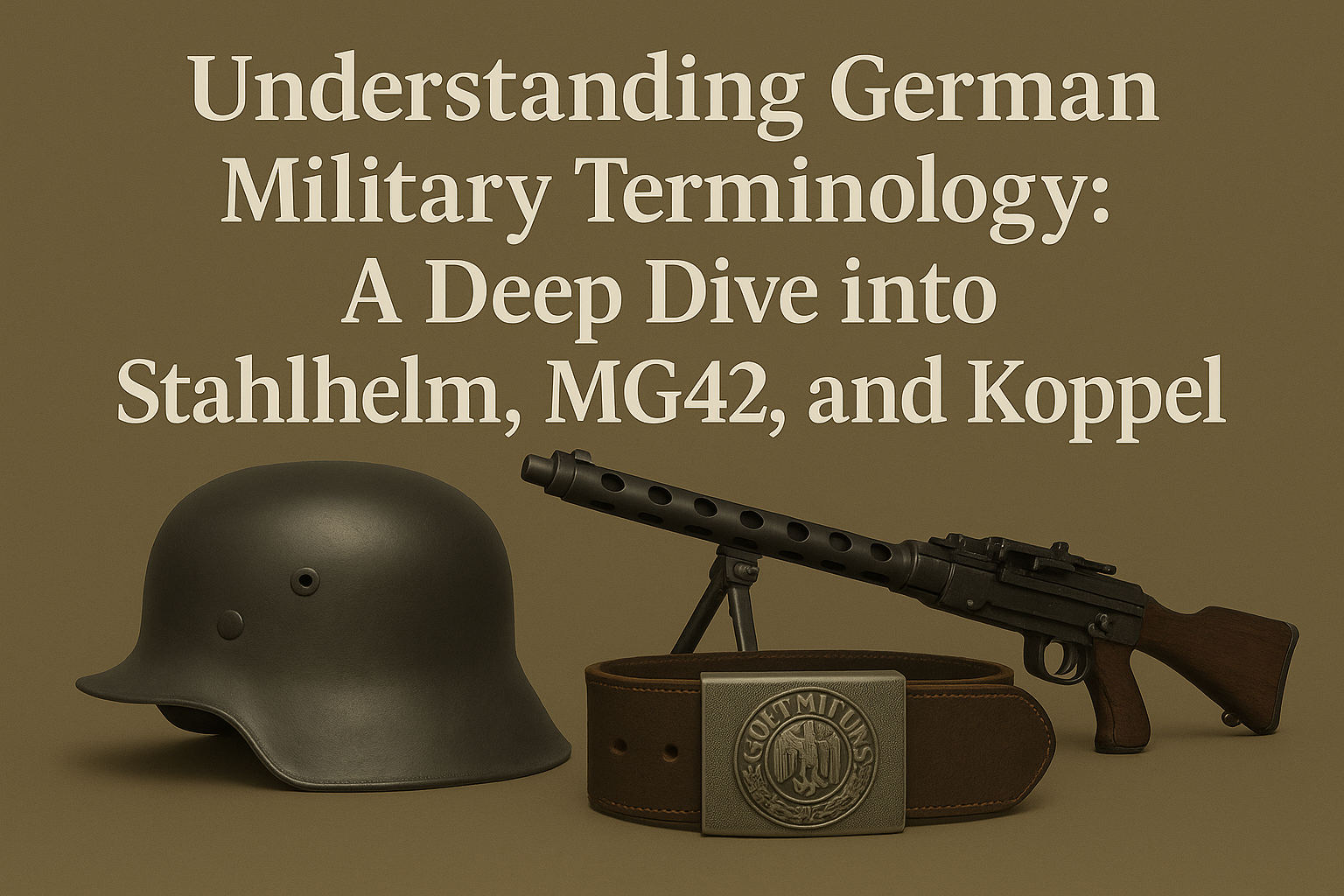
Understanding German Military Terminology: A Deep Dive into Stahlhelm, MG42, and Koppel
Published on May 14, 2025
Understanding German Military Terminology: A Deep Dive into Stahlhelm, MG42, and Koppel
Introduction: Why German Military Terminology Still Matters
WW1 German military history is not only vast—it’s detailed, systematic, and richly coded in a language of its own. Terms like “Stahlhelm,” “Koppel,” and “MG42” are more than just labels—they symbolize innovation, discipline, and legacy. Understanding these terms is crucial for enthusiasts, historians, and collectors alike who want to engage deeply with German military culture, particularly from the First and Second World Wars.
In this article, we’ll break down essential terminology, exploring its background, usage, and connection to the uniforms and gear still studied and preserved today.
1. M1916 Stahlhelm: The Icon of German Combat
One of the most recognizable symbols of German soldiers during World War I and early World War II was the Stahlhelm, literally meaning "steel helmet."
Origin and Evolution
Introduced in 1916 to replace the traditional leather Pickelhaube, the M1916 Stahlhelm was a response to the increasingly lethal nature of trench warfare. As artillery became deadlier, the need for improved head protection grew. The Stahlhelm answered that call with its solid, molded steel shell and deep coverage.
Design Features
- Shape: The flared sides and sloped design protected against shrapnel and fragments.
- Material: Pressed from a single steel sheet, offering strength and durability.
- Ventilation Lugs: Two side lugs were originally designed for mounting a frontal armored brow plate.
- Liner: A three-pad leather liner ensures a secure, comfortable fit.
Its silhouette became iconic, used not only in WWI but as a visual basis for later helmets, including the M1935, M1940, and M1942. Even today, its influence can be seen in modern helmet designs.
2. MG42 Caliber and Function: "Hitler’s Buzzsaw"
The MG42, short for Maschinengewehr 42, emerged during WWII as a game-changing piece of weaponry for the Wehrmacht. It replaced the earlier MG34, boasting improved reliability and lower production costs.
MG42 Caliber: 7.92×57mm Mauser
The MG42 was chambered for the 7.92×57mm Mauser cartridge, a standard German military round. This cartridge provided a balance of stopping power, range, and speed, crucial for both offensive and defensive engagements.
Firepower and Speed
What truly set the MG42 apart was its rate of fire—up to 1,200 to 1,500 rounds per minute. Its distinct sound earned it the nickname “Hitler’s Buzzsaw” among Allied troops.
Other Characteristics:
- Durability: Built from stamped steel for faster manufacturing.
- Portability: Infantry could mount or use this with a bipod.
- Tactical Use: Played both support and suppressive roles, dominating open battlefields and urban skirmishes alike.
Its legacy didn’t end with WWII. Many nations adopted the MG42’s core design principles in their post-war light and medium machine guns, some of which remain in use today.
3. The Koppel Belt: Backbone of German Soldier Gear
While helmets and guns attract most of the attention, no soldier was truly battle-ready without a Koppel. The Koppel, or Koppeltragegestell, was more than just a belt—it was the anchor of the German infantryman’s loadout.
Definition and Use
The Koppel was the standard utility belt used by German forces, serving to attach and carry gear such as ammunition pouches, bayonets, canteens, bread bags, entrenching tools, and other vital equipment.
Design and Material
- Construction: Typically made from high-grade leather, later replaced with synthetic materials due to wartime shortages.
- Buckle (Koppelschloss): Featured an embossed metal buckle, often engraved with slogans such as "Gott mit uns" (God With Us) or national emblems like the Wehrmacht eagle.
- Function: Distributed weight across the hips for easier mobility and longer endurance in combat.
The belt was often paired with Y-straps or suspenders for additional support, helping soldiers carry gear effectively during long marches or combat operations.
4. Other Key German Military Terms You Should Know
To fully understand German military gear, it helps to familiarize yourself with related terminology. Here are some terms collectors and enthusiasts frequently encounter:
- Wehrmacht: The unified armed forces of Nazi Germany (Heer – Army, Luftwaffe – Air Force, Kriegsmarine – Navy).
- Feldbluse: The standard issue field tunic worn by Wehrmacht soldiers.
- Gasmaske: Gas mask issued due to the fear of chemical warfare, stored in a cylindrical metal container.
- Sturmgepäck: The assault pack used to carry a soldier’s personal and combat gear.
- Zeltbahn: A multi-purpose poncho that could be used as shelter halves, rain gear, or camouflage.
Understanding these words deepens your appreciation of not only the language but also the lifestyle and challenges of the soldiers who used this gear.
5. Collecting and Preserving German Military Gear
Today, authentic items like the M1916 Stahlhelm, MG42 replicas, and vintage Koppel belts are treasured by collectors, museums, and reenactors. However, it’s crucial to verify authenticity due to the proliferation of replicas and reproductions.
Tips for Collectors:
- Research Markings: Many genuine items include manufacturer stamps, lot numbers, or regimental insignias.
- Material Quality: Older, authentic pieces show signs of age—leather cracking, patina, or even minor rusting on steel.
- Documentation: Provenance increases the value and historical context of any item.
Conclusion: The Language of Legacy
German military terminology encapsulates more than just definitions—it tells the story of a nation’s tactical evolution, design ingenuity, and battlefield resilience. From the unmistakable curve of the M1916 Stahlhelm to the blistering fire rate of the MG42 and the utilitarian strength of the Koppel belt, each term represents a cornerstone of 20th-century military history.
Whether you're a seasoned historian or a new enthusiast, exploring and understanding this terminology brings you closer to the legacy left by these iconic pieces of military heritage.
